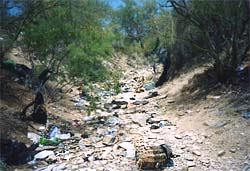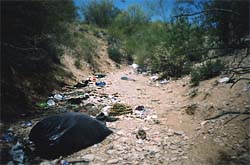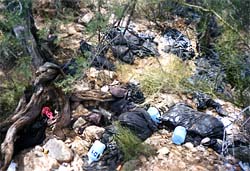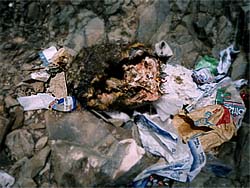1 posted on
04/14/2005 10:03:08 AM PDT by
HiJinx
Navigation: use the links below to view more comments.
first 1-20, 21-24 next last
To: Trteamer; B58Hustler
trteamer, you asked for it, here it is.
B58Hustler, fantastic work and you should keep this up.
2 posted on
04/14/2005 10:04:46 AM PDT by
HiJinx
(My Momma tol' me that if you gotta sneak, you're wrong...and you know it.)
To: HiJinx
Thanks for posting this. It's disgusting.
4 posted on
04/14/2005 10:10:54 AM PDT by
retrokitten
(I heart Tony Snow)
To: HiJinx

U.S. Constitution Article 4 Section 4:"The United States shall guarantee to every State in this Union a Republican Form of Government,
and shall protect each of them against Invasion;"
U.S. Constitution Article 1 Section 8 Clause 15: "The Congress shall have Power to provide for calling forth the Militia to execute the Laws of the Union, suppress Insurrections
and repel Invasions;"
8 posted on
04/14/2005 10:15:51 AM PDT by
Travis McGee
(----- www.EnemiesForeignAndDomestic.com -----)
To: HiJinx
As you know, some of us have come up with some creative uses for some of that criminal invader trash.
This is one of my favorite pictures of all time:

On the night of Saturday, 27 September 2003, twenty-two bags of garbage were left leaning against the door of Rep. Jim Kolbe's (RINO-AZ) office in Sierra Vista, Arizona. (See http://www.svherald.com/articles/2003/09/29/news/news1.txt) The garbage was gathered earlier that day from a lay-up site used by criminal invaders as they crossed through Cochise County, Arizona on their way north. The garbage was unsightly, smelly, and prevented access to Congressman Kolbe's office until it was removed. The illegal alien garbage was stuffed into bags provided by Cochise County which are clearly labeled "Cochise County UDA Cleanup". UDA means "Undocumented Aliens". Sanitation engineers were forced to come and remove the trash and to sanitize the sidewalk upon which the trash sat and the wall and door against which the trash was leaned in order for Rep. Kolbe's office to resume normal operations.
Rep. Kolbe's snitty little office manager, Bernadette Polley, looks on in disgust. She demonstrates the same look of disgust we display whenever Rep. Kolbe pollutes our district with his presence.
9 posted on
04/14/2005 10:17:35 AM PDT by
Spiff
(Don't believe everything you think.)
To: HiJinx
10 posted on
04/14/2005 10:21:09 AM PDT by
k2blader
(Immorality bites.)
To: HiJinx
THE BORDER: Illegals turn desert into trash dump
$2M to be spent on cleanup in S. Arizona
LUKE TURF
Tucson Citizen
HUACHUCA MOUNTAINS - Stepping over bear and mountain lion dung with birds singing and snakes rattling nearby, three retiree hikers take a rocky trail a few miles into the backcountry. They go all the way to a once-beautiful ravine - now filled with a disheartening sea of trash.
A cool breeze worries one of the hikers, 69-year-old Alexa Cottingham. She knows that winds carry trash from a nearby illegal immigrant campsite over a cliff and into the ravine. There it will sit until the next breeze pushes it farther down the stream of waste.
Discarded pants and plastic bags are caught in a sotol plant. Hundreds of discarded water jugs are only the beginning of the problem. Jumex drink cans, tuna tins, Coca-Cola containers, pants, shoes, women's underwear and discarded feminine hygiene products, chips and bread bags, emptied canned fruit containers, hats and a tequila bottle blanket the landscape.
"We're used to the trash along the road and all of that," says Cottingham, who lives in Hereford near the border. "But having it this extensive, it was just as if they brought all of Mexico here. ... I didn't know how people could have that much trash."
It's been a problem as long as people have illegally crossed the deserts. It increased in southern Arizona in the late 1990s when the U.S. Border Patrol cracked down on illegal immigration into Texas and California, pushing illegal immigrants - and their trash - into Arizona's remote deserts.
To Cottingham and her fellow hikers, the problem seems overwhelming. It's just one example of pristine Sonoran Desert turned into a trash dump. Many southern Arizonans see it every day. About $2 million in newly approved federal funds should help address - though admittedly not solve - the problem in the short term, according to the Arizona congressman who helped secure the money. But some fear it's like trying to dam a river with a wine cork.
To combat the trash, Republican congressman Jim Kolbe of Tucson helped secure the money, half in this fiscal year's budget and half in the next one. At least $695,000 is already being put to use, according to Beau McClure, special assistant for international programs for the Bureau of Land Management, the federal agency dispersing the funds.
It's just a fraction of the $20 million a congressional report estimates is needed to remove trash in southeastern Arizona's deserts. McClure says he's putting together a statewide estimate of how much money is needed for the border region, because the problem isn't limited to one corner of the state.
The Tohono O'odham Nation, where trash piles up as quickly as officials can measure it, is ineligible for any of the $2 million, McClure says.
An environmental specialist with the tribe, Ken Cronin, says about 1,500 immigrants sneak through the reservation daily. Each leaves an average of eight pounds of trash - totaling six tons - a day, he said.
"It's just blanketed," Cronin says of the tribal land. "It's pretty tremendous; there's a pretty severe visual impact."
Many of the trails and campsites used by illegal immigrants are in remote areas, but many of the places where they get picked up are close to residential areas. There they often drop what they're carrying, Cronin says.
Cronin estimates the O'odham need about $1.67 million to clean up their reservation.
Off tribal land, McClure says, the $695,000 he received in March has been put to such uses as an Earth Day cleanup in which about 40 volunteers from 20 agencies picked up garbage in the San Pedro Riparian National Conservation Area near Hereford. He says "considerably more than half" of the money will go to other city, county and private organizations as compensation for cleaning the terrain. Most of the rest will be used for supplies such as gloves and trash bags.
"It's certainly not a solution to the problem; it's just a means to take care of some of the damage that's occurring," McClure says. "And it's going to be trashed again as the thousands of people come through the border - each day, actually."
That worries one of Kolbe's counterparts.
Democratic congressman Raúl Grijalva of Tucson applauds Kolbe for bringing the funds to the area. Yet he is disappointed Congress hasn't made any progress on illegal immigration.
"It's a surface issue. The problem is much more fundamentally deep than that," Grijalva says. "The irony is that we continue to deal with the surface problem."
McClure says the wildlife disturbance, habitat destruction and degradation of wildlife health caused by the human waste will continue to destroy the ecosystem.
Beyond the dangers the trash poses to wildlife lies one of the biggest fears of Cottingham's fellow hikers.
Bill Clark, 74, pauses on the trail. He shifts his wooden hiking stick between his hands and bends to pick up a remnant of one of wildlife's biggest threats - fire. Between his fingers Clark holds a cigarette butt. He is also quick to point out nearby abandoned campfires, just three feet below the dry limbs of a tree.
This year's Eureka fire, in the foothills of the Huachucas, not far from here, burned about 40 acres. Officials believe illegal immigrants started a signal or cooking fire that got out of control.
"This is what scares the hell out of me. You see that fireplace there," Clark says. "See, it's hidden so nobody could see it, but it could get away ... and down that canyon real fast."
More trashed sites are likely until illegal immigrants stop coming over the border or start cleaning up after themselves. In the meantime, several groups addressing other border issues also take to the desert to pick up their trash.
Humane Borders, which maintains water stations in the desert for illegal immigrants, heads trash pickups once a month. Groups opposed to illegal immigration - such as Ranch Rescue, an armed group based in Texas that patrols private ranches, and Civil Homeland Defense, a sometimes-armed citizens patrol based in Tombstone - also regularly organize clean-ups.
And U.S. Border Patrol agents in each of the agency's stations organize periodic cleanups.
Until a more concrete solution is found, the federal money will be the biggest funding effort.
Over on tribal land, Jim Fletcher, the federal Environmental Protection Agency's tribal specialist on the border, is trying to get about $50,000 in grants to combat the problem.
The money would go toward cleanups, recycling, warning signs and even trash cans.
"We're about ready to try anything at this point in time," Fletcher says.
12 posted on
04/14/2005 10:40:00 AM PDT by
Spiff
(Don't believe everything you think.)
To: HiJinx
I would certainly expect that the President would need to be informed of this desecration of Arizona. I would further expect that he would coordinate cleanup efforts with his NAFTA partner Vicente Fox.
/sarcasm
13 posted on
04/14/2005 10:42:49 AM PDT by
afnamvet
(31st Fighter Wing Tuy Hoa AB RVN 68-69 "Return With Honor")
To: HiJinx
Patrols, crossers trash border's pristine desert
Conservationists fear impact deeper into wilderness
Mary Jo Pitzl
The Arizona Republic
Mar. 25, 2005 12:00 AM
The trail of environmental destruction along Arizona's border with Mexico is growing at increasingly rapid rates, overwhelming land managers and making a mockery of the wilderness designation those lands carry.
Vast stretches of borderland in southwestern Arizona, deemed pristine respites by Congress, are pockmarked with the debris of illegal immigration from rusting cars to the rutted trails they and their Border Patrol pursuers cut into the fragile desert crust.
When measured against the threats to homeland security or the real risk of imperiling human life, wilderness protections rank a distant third in priority.
This has roiled some conservationists, who complain that Border Patrol activities have pushed too far into the desert interior while intruding more and more on the natural environment.
They're especially critical of a Border Patrol plan that proposes to expand off-road operations, introduce towering stadium-style lights in critical enforcement areas and build more roads and fences.
The public-land managers who run these wilderness areas say they're in the difficult position of trying to protect natural resources and wildlife while acknowledging the needs of border security.
So wilderness advocates are now pushing to move control efforts closer to the border. They hope the Border Patrol can contain the illegal tide without lapping far into the desert, although they acknowledge it would take more money to get increased manpower and better technology.
"I think you can solve a lot of it by looking into Mexico," said Fred Goodsell, founder of an Ajo-based group he calls Sonoran Desert Protectors.
A volunteer for the Cabeza Prieta National Wildlife Refuge, Goodsell argues that the Border Patrol should be equipped with detection devices that can be pointed south, instead of north, with the idea of intercepting undocumented immigrants as soon as they cross the international border.
The Border Patrol acknowledges that control efforts close to the border would stop much of the damage farther into the desert.
What's lacking, however, is money, not only for technology but for the increased manpower and other equipment needed to draw a tighter net around a porous border, said Joe Brigman, spokesman for the Border Patrol's Yuma sector.
The patrol agency tries to be environmentally sensitive, he said, by limiting its off-road usage as much as possible and relying on airplanes and helicopters for patrol.
But they've drawn scorn from some conservationists for the use of Humvees, a practice that Brigman defends as necessary to protect officer safety.
"The bad guys in this whole scenario are not the Border Patrol," he said. "It's the illegal-alien smugglers and the drug smugglers. They're the ones coming in illegally."
Land managers say the shifting trends in border policy have brought intensive and intrusive enforcement efforts to remote areas.
"Border Patrol does cause a lot of environmental damage, but imagine where we'd be if the Border Patrol were not out there," said Roger Di Rosa, manager of the Cabeza Prieta refuge.
Besides, he said, how do you argue against national security? The person who gets into the United States because the Border Patrol had its hands tied by environmental concerns could very well be the terrorist who will ignite the next Sept. 11-type attack, he said, citing a common concern.
There are ways to respect wilderness and the environmental protections it entails while still providing security, said Superintendent Kathleen Billings of Organ Pipe Cactus National Monument.
A prime example is the vehicle-barrier fence along Organ Pipe's border with Mexico. So far, 18 miles of a steel-and-concrete fence are in place, blocking cars, SUVs and trucks, many of them carrying bulky loads of drugs. Billings said the results were immediate.
"It essentially has stopped all illegal-vehicle traffic," she said, pointing to the fence's hip-high steel crossbar.
"But it has increased the vehicles crossing at the edges."
And that is a metaphor for the larger problem along the border in southwestern Arizona.
Di Rosa calls it "shifting on your neighbor." Put up a barrier in one spot, he said, and the immigrant traffic simply moves to a less-restricted location.
There also are long stretches along the border where normal post-and-wire fencing have been stolen.
Even if the entire U.S.-Mexican border were equipped with the vehicle-barrier fence (a costly impossibility, given Organ Pipe plans to spend $17 million to build 29 miles of fence), there would still be foot traffic, the Border Patrol's Brigman says.
"There's tremendous amounts of problems caused by the walk-in traffic," he said.
A recent tour of the wilderness areas in southwestern Arizona gave ample proof of that. In Organ Pipe, rusting tin cans, shattered plastic water jugs, socks and human waste accumulate near popular watering holes. Spray-painted graffiti deface rocks and cactuses alike.
Last year, the National Parks Conservation Association named Organ Pipe one of the nation's 10 most-endangered national parks due to the stresses of border traffic.
Di Rosa is shopping around the idea that the cumulative effects of border problems, from safety concerns to terrorism prevention to environmental damage, amount to a disaster, and that such a disaster should qualify for emergency federal assistance.
"It would be a way for the land-management agencies here, which are way overtaxed, to get some kind of funding to deal with this," he said.
14 posted on
04/14/2005 10:44:42 AM PDT by
Spiff
(Don't believe everything you think.)
To: HiJinx
Wonder where all the environmentalists are?

16 posted on
04/14/2005 10:52:20 AM PDT by
TheLion
To: HiJinx
17 posted on
04/14/2005 10:53:45 AM PDT by
Spiff
(Don't believe everything you think.)
To: HiJinx
20 posted on
04/14/2005 10:57:57 AM PDT by
TheLion
To: HiJinx
21 posted on
04/14/2005 11:05:23 AM PDT by
ßuddaßudd
(7 days - 7 ways (but you must follow the instructions carefully))
To: HiJinx
I would re-do this thread and call it something that will get more attention.
Some Ideas for a title:
1. Eco-Destruction on our southern border.
2. Environmental Disaster on our southern border.
3. Trash left behind by Illegal Aliens destroying the eco-system on our southern border.
Well, you get the idea.
23 posted on
04/14/2005 11:10:16 AM PDT by
TheLion
To: HiJinx; Spiff; backhoe
27 posted on
04/14/2005 11:44:49 AM PDT by
TheLion
To: HiJinx
America's leaders are lunatics to turn their eyes away from this s..t. Our leaders are traitors to this country. They make Tokyo Rose look like a Sunday school teacher.
32 posted on
04/14/2005 1:20:21 PM PDT by
swampfox98
(Michael Reagan: "It's time to stop the flood.")
To: HiJinx; B58Hustler
Thank you for a very eye-opening post and the pictures.
39 posted on
04/14/2005 3:27:18 PM PDT by
JLO
To: HiJinx; B58Hustler
Thanks to both of you for putting this up. I'll lend you some extra credibility, because I've been down there and I've seen it. Every American ought to see it.
Now, what we need to do is find some pictures of the damaged ranch fences and what they do to the livestock.
41 posted on
04/14/2005 3:30:14 PM PDT by
AZ_Cowboy
("Be ever vigilant, for you know not when the master is coming")
To: HiJinx; Spiff; DumpsterDiver
From your link above....I was right about the environmentalists.
As DumpsterDiver says, this may be a way to get more exposure about this problem. These people must be squirming over this.
Dumping of Trash, Waste, Endemic in State with Flood of Illegal Immigration
Bitter Division for Sierra Club on Immigration
By Felicity Barringer, The New York Times, March 16, 2004
Immigration is creating a bitter leadership struggle in the Sierra Club, a 112-year-old organization of 750,000 members that works to bring conservation and pollution issues to public attention.
Barringer writes that the Sierra Club is struggling over "whether to advocate tough immigration restrictions as a way to control environmental damage that has been associated with rapid population growth."
U.S. Census Bureau figures show that nearly 40 percent of the U.S. population growth over the last 10 years has been a result of direct immigration; many of the immigrants have settled in California, the Sierra Club's home base.
http://usinfo.state.gov/eap/east_asia_pacific/chinese_human_smuggling/smuggling_in_the_press/environment.html
53 posted on
04/14/2005 5:08:41 PM PDT by
TheLion
To: HiJinx
interesting that the radical enviro's of tucson are not down there protesting. (/s)
57 posted on
04/14/2005 5:22:08 PM PDT by
ken21
( wasn't fr supposed to be a place to discuss ideas?)
To: HiJinx
Excellently factual.
A picture is worth a thousand words Bump.
63 posted on
04/14/2005 5:58:10 PM PDT by
DoctorMichael
(The Fourth Estate is a Fifth Column!!!!!!!!!!!!!!!!!!!)
Navigation: use the links below to view more comments.
first 1-20, 21-24 next last
FreeRepublic.com is powered by software copyright 2000-2008 John Robinson





 http://www.desertinvasion.us/invasion_pictures/pics_waddell_dam.html
http://www.desertinvasion.us/invasion_pictures/pics_waddell_dam.html